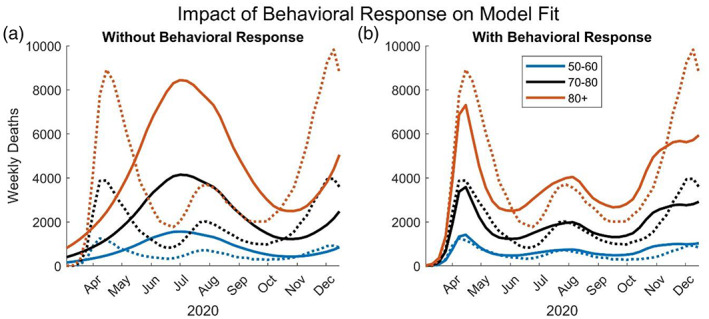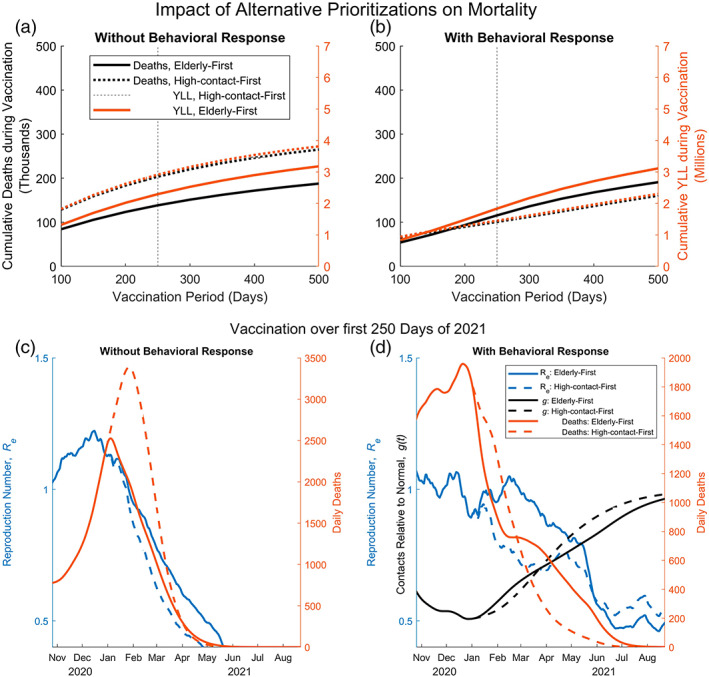下载PDF
{"title":"Behavioral responses to risk promote vaccinating high-contact individuals first.","authors":"Hazhir Rahmandad","doi":"10.1002/sdr.1714","DOIUrl":null,"url":null,"abstract":"<p><p>How should communities prioritize COVID-19 vaccinations? Prior studies found that prioritizing the elderly and most vulnerable minimizes deaths. However, prior research has ignored how behavioral responses to risk of disease endogenously change transmission rates. We show that incorporating risk-driven behavioral responses enhances fit to data and may change prioritization to vaccinating high-contact individuals. Behavioral responses matter because deaths grow exponentially until communities are compelled to reduce contacts, with deaths stabilizing at levels that oblige higher-contact groups to sufficiently cut their interactions and slow transmissions. More lives may be saved by vaccinating and taking those high-contact groups out of transmission chains earlier because the remaining groups will take more precautions while waiting for their turn for vaccination. These findings are especially important considering the need for further vaccination in many countries, the emergence of new variants, and the expected challenge of distributing new vaccines in the coming months and years. © 2022 The Author. <i>System Dynamics Review</i> published by John Wiley & Sons Ltd on behalf of System Dynamics Society.</p>","PeriodicalId":51500,"journal":{"name":"System Dynamics Review","volume":"38 3","pages":"246-263"},"PeriodicalIF":1.7000,"publicationDate":"2022-07-01","publicationTypes":"Journal Article","fieldsOfStudy":null,"isOpenAccess":false,"openAccessPdf":"https://ftp.ncbi.nlm.nih.gov/pub/pmc/oa_pdf/34/2b/SDR-38-246.PMC9537883.pdf","citationCount":"10","resultStr":null,"platform":"Semanticscholar","paperid":null,"PeriodicalName":"System Dynamics Review","FirstCategoryId":"91","ListUrlMain":"https://doi.org/10.1002/sdr.1714","RegionNum":3,"RegionCategory":"管理学","ArticlePicture":[],"TitleCN":null,"AbstractTextCN":null,"PMCID":null,"EPubDate":"2022/8/23 0:00:00","PubModel":"Epub","JCR":"Q3","JCRName":"MANAGEMENT","Score":null,"Total":0}
引用次数: 10
引用
批量引用
Abstract
How should communities prioritize COVID-19 vaccinations? Prior studies found that prioritizing the elderly and most vulnerable minimizes deaths. However, prior research has ignored how behavioral responses to risk of disease endogenously change transmission rates. We show that incorporating risk-driven behavioral responses enhances fit to data and may change prioritization to vaccinating high-contact individuals. Behavioral responses matter because deaths grow exponentially until communities are compelled to reduce contacts, with deaths stabilizing at levels that oblige higher-contact groups to sufficiently cut their interactions and slow transmissions. More lives may be saved by vaccinating and taking those high-contact groups out of transmission chains earlier because the remaining groups will take more precautions while waiting for their turn for vaccination. These findings are especially important considering the need for further vaccination in many countries, the emergence of new variants, and the expected challenge of distributing new vaccines in the coming months and years. © 2022 The Author. System Dynamics Review published by John Wiley & Sons Ltd on behalf of System Dynamics Society.
对风险的行为反应促使首先为高接触者接种疫苗。
社区应如何优先接种COVID-19疫苗?先前的研究发现,优先照顾老年人和最脆弱的人可以最大限度地减少死亡。然而,先前的研究忽略了对疾病风险的行为反应如何内源性地改变传播率。我们表明,纳入风险驱动的行为反应增强了对数据的契合性,并可能改变对高接触人群接种疫苗的优先级。行为反应很重要,因为死亡人数呈指数增长,直到社区被迫减少接触,死亡率稳定在迫使高接触群体充分减少互动和减缓传播的水平。通过接种疫苗并使这些高接触人群更早地脱离传播链,可以挽救更多的生命,因为其余人群在等待接种疫苗时将采取更多预防措施。考虑到许多国家需要进一步接种疫苗、新变种的出现以及在未来数月和数年内分发新疫苗的预期挑战,这些发现尤其重要。©2022作者。由John Wiley & Sons Ltd代表系统动力学学会出版的《系统动力学评论》。
本文章由计算机程序翻译,如有差异,请以英文原文为准。




 求助内容:
求助内容: 应助结果提醒方式:
应助结果提醒方式:


